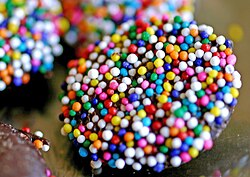Nonpareils
This article needs additional citations for verification. (May 2022) |
 Multicolor nonpareil balls coating the top of a chocolate nonpareil | |
| Alternative names | Sprinkles (US and Canada) Jazzies (UK) Hundreds and thousands (UK, South Africa, Australia and New Zealand) |
|---|---|
| Type | Confectionery |
| Main ingredients | Sugar, starch, food coloring |
Nonpareils are a decorative confectionery of tiny balls made with sugar and starch, traditionally an opaque white but now available in many colors. They are also known as hundreds and thousands in Australia, New Zealand, South Africa[1] and the United Kingdom.
Their origin is uncertain, but they may have evolved out of the pharmaceutical use of sugar, as they were a miniature version of
The term nonpareil also may refer to a specific confection, made using nonpareils – namely, discs of chocolate coated with nonpareils, which also are known as chocolate nonpareils, freckles, or jazzies.
History
Nonpareils can be traced back to 17th century French recipes, highlighting the use of “nonpareils” as an alternative topping replacing sugar.[4][5]
An 18th-century
In 1844, Eleanor Parkinson, of a well-known Philadelphia family of professional confectioners, first published her book The Complete Confectioner,[7] in which she described how to make nonpareils following her comfit-making procedure, which involved multiple hot pots and hot syrup.
Görlitz, Germany was the birthplace of the German version of nonpareils, popularly known in Germany as Liebesperlen (German: love pearls). Invented by confectioner Rudolf Hoinkis (1876–1944), the name derives from a conversation Hoinkis had with his wife, proclaiming he loved her like these "pearls", the nonpareil. Unsure of what to call the treat he invented, his wife suggested calling them love pearls, and the name stuck. The factory where he first manufactured the treat, founded in 1896, is now run by his great-grandson, Mathias.
In the United States, traditional nonpareils gave way for most purposes by the mid 20th century to "
Candy-covered anise seeds called muisjes, sometimes mistaken for traditional nonpareils, are sometimes offered at breakfast in the Netherlands to be served on bread and butter. They are, however, usually served on rusk to celebrate the birth of a child. This is known as "beschuit met muisjes".

In Australia and New Zealand, as well as South Africa and the UK, spherical nonpareils are known as "hundreds-and-thousands". In Australia and New Zealand, they are often used to decorate cup cakes (patty cakes) or toffee, or on buttered white bread triangles as fairy bread, for children's birthday parties.
Chocolate nonpareils
The term "nonpareils" can also refer to a specific confection: a round flat chocolate drop with the upper surface covered in nonpareils.[8] This confection is also referred to as chocolate nonpareils. Ferrero makes a variety marketed in some countries as Sno-Caps.
In Australia, these confections are commonly known as chocolate freckles or simply freckles. Nonpareils are also sold in the United Kingdom as "Jazzies", "Jazzles," "Jazz drops," and "Snowies" (the latter being of the white chocolate variety).
The coating of nonpareils is referred to as hundreds and thousands in Australia, New Zealand, South Africa, and the UK. The Canadian company Mondoux sells them as "Yummies".
See also
References
- ^ Sivignon, Cherie (2020-01-19). "We got it made: The woman who invented Hundreds & Thousands biscuits". Stuff. Retrieved 2022-10-18.
- ISBN 1-58234-307-1.
- ISBN 0-609-60971-8.
- ^ Oudin, César (1660). Tesoro de las dos lenguas Espanola y Francesa.
- ^ Massialot, François (1692). "Nouvelle instruction pour les confitures, les liqueurs, et les fruits".
- ^ Leslie, Eliza. "Seventy-five Recipe for Pastry, Cakes, and Sweetmeats". Feeding America: The Historic American Cookbook Project. Retrieved 2009-11-19.
- ^ Parkinson, Eleanor. "The Complete Confectioner". Feeding America: The Historic American Cookbook Project. Retrieved 2009-11-19.
- ^ "Definition of Nonpareil by Merriam-Webster". www.merriam-webster.com. Retrieved 30 November 2016.
